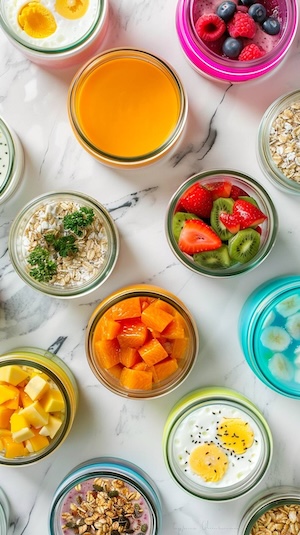PCOS for Picky Eaters: 30 Simple Meal Ideas
Discover 30 simple pcos meals for picky eaters that help manage symptoms. Easy pcos meals picky eaters will love, with practical tips and hormone-balancing ingredients.
Transform your health with tailored 7-day meal plans designed specifically for PCOS management. Just $7/month or $59/year.
Get it now →2 cups warm water (100 degrees F)
1/2 teaspoon active dry yeast
1 teaspoon raw cane sugar (turbinado)
5 cups all-purpose, unbleached, unsifted flour
Sea salt
1 tablespoon olive oil
Your favorite tomato sauce
Grated mozzarella cheese
Your favorite grated or shredded cheeses, optional
Assorted precooked meats, optional
Assorted raw vegetables, optional
Chopped fresh flat-leaf parsley
Italian herb blend
To allow for more space, remove the top rack from the oven. Place the pizza stone, if using on the lower rack. Cook's Note: A cookie sheet can be used if you do not have a pizza stone but you do not have to preheat it.
Preheat the oven to 500 to 550 degrees F. Heat up the pizza stone for at least 30 minutes.
Choose an open workspace; counter or large cutting board.
Pour the warm water into the mixing bowl. Add the yeast and turbinado sugar and whisk together. Continue mixing and slowly add 4 cups flour. Mix completely. The dough should be very thick and lump free. Remove the whisk and set aside.
Place the remaining 1 cup flour on the countertop. With your hand, form a circular depression in the middle of the flour, leaving some flour on the bottom. With a rubber spatula, transfer the dough to the flour.
Using the heels of your hands, slowly knead the flour and dough together. Scrape under the dough (with the dough scraper) and add more flour underneath as necessary to prevent the dough from sticking. Add more flour as needed. Work the dough by hand so that it's not too loose or sticky. Knead in 1 teaspoon sea salt.
Continue kneading the dough for 3 minutes. Cut the dough in half with the dough scraper and examine the interior; if the dough is too soft, the "wall" will slump down. In this case, continue kneading and slowly add more flour. The dough is ready when the interior wall remains upright and vertical. If too much flour is added, the dough becomes unworkable.
Cut the dough in 4 equal portions and shape each into a ball. With the pastry brush and olive oil, coat a tray or plate with a light coating of olive oil. Place the dough balls on it and paint each dough ball with a light layer of olive oil. Allow the dough to rest (proof) at room temperature for approximately 20 to 30 minutes.
To form the pizza, roll out the dough ball on a floured surface with the rolling pin. Sprinkle additional flour on top of the ball to keep it from sticking. To make a round pizza, continuously flip the pizza "skin" over and over as you roll it. The crust will get thinner and thinner as you go. Add a little flour to both sides if needed to avoid any sticking. Fix any holes by pinching the dough back together.
When the pizza is about 14-inches wide, rub a micro layer of flour across the top of the skin, then flip it over and onto the wooden peel. If you do not have a peel, use a cookie sheet. Shake the peel to make sure the skin slides easily. If not, add additional flour and repeat.
Decorate the pizza with a thin layer (1/8-inch) of quality sauce. Leave a 1-inch border (the cornicione or crust) at the outer edge. Distribute a light layer of your favorite cheeses, including mozzarella on top. Add the precooked meats or raw vegetables, if using on top of the cheese. Garnish the pizza with a pinch of freshly chopped parsley and dried Italian herbs. Overall, the fewer the toppings the better: less is more.
Carefully pat down all of the toppings so they won't slide around and test-shake the pizza to make sure it will slide off the peel. Shake the peel again a bit as you slide the pizza onto the preheated pizza stone. Cook the pizza for 8 to 15 minutes or until the cornicione is golden brown. Remove the pizza with the metal peel and let it cool for a minute or two before cutting and serving.
If you are using a cookie sheet, it is not necessary to preheat it. Paint a light layer of olive oil on top of the sheet, and place the skin on it. Then add sauce, cheese and toppings.
This recipe was provided by professional chefs and has been scaled down from a bulk recipe provided by a restaurant. The Food Network Kitchens chefs have not tested this recipe, in the proportions indicated, and therefore, we cannot make any representation as to the results.

You know the drill: Alarm goes off. You hit snooze. Rush around frantically. Skip breakfast AGAIN because there's no time. By 10am, you're hangry, your blood sugar is all over the place, and your PCOS symptoms are already acting up.
Sound familiar?
Finally – a meal prep system designed specifically for women with PCOS who refuse to let chaotic mornings derail their health goals.
In just ONE hour on Sunday, you can transform your entire week:
"I went from skipping breakfast 4 days a week to having delicious, hormone-supporting meals ready every morning. My energy is more stable and my cravings have disappeared!"
– Sarah M.
Stop letting chaotic mornings control your health.
Get your hormone-happy mornings starting this Sunday.
→ Get Your 60-Minute Solution Now
Transform your health with tailored 7-day meal plans designed specifically for PCOS management. Just $7/month or $59/year.
Get it now →Serving Size: 4
| Amount Per ONE Serving | ||
|---|---|---|
| Calories 0 kcal | ||
| Fat 0 g | ||
| Carbohydrate 0 g | ||
| Protein 0 g | ||
💡 Introducing the 10/10 PCOS Solution:
Ten Delicious Crockpot Recipes that take just 10 minutes to prep!
Say goodbye to hours in the kitchen and hello to clean, PCOS-friendly meals made effortlessly.
👉 Click here to grab your 10/10 PCOS Solution today! Try The 10/10 PCOS Solution: Ten Crockpot Recipes That Take Just Ten Minutes to Prep
Managing PCOS can be challenging, but you don't have to do it alone. Join our supportive community to connect with others who understand what you're going through, share tips, and get encouragement. Here's how you can get involved:
Subscribe to our Newsletter: Receive PCOS-friendly recipes, tips, research updates, and more delivered straight to your inbox. Stay informed and empowered with the latest information and support.
Join our Telegram Channel: Stay updated with the latest tips and advice on managing PCOS.
Follow PCOS Meal Planner on Facebook: Engage with our community, participate in discussions, and get support from others.
Break the cycle with the PCOS Meal Planner - your personalized guide to eating better, feeling better, and managing PCOS symptoms. Take control today!

Forget the frustrating cycle of weight loss attempts, endless medications, and living in discomfort. Introducing the PCOS Meal Planner. A meal planning guide that goes beyond temporary fixes to offer a comprehensive strategy, empowering you to ignite a transformation towards lasting health and happiness. Step into a world where you control your PCOS, not the other way around.
Unlock Your PCOS Freedom Now.
Discover 30 simple pcos meals for picky eaters that help manage symptoms. Easy pcos meals picky eaters will love, with practical tips and hormone-balancing ingredients.
Discover 15 delicious overnight oats for PCOS recipes that help balance hormones and manage symptoms. Easy, nutritious breakfast ideas perfect for women with PCOS.
Discover the best cereal for PCOS with our expert rankings. Compare brands, check ingredients, and find PCOS friendly cereal that supports hormonal balance.
Learn how to transition away from fruit when starting a ketogenic diet for PCOS. Discover gradual strategies, fruit alternatives, and practical tips for success.
Discover 5 delicious PCOS banana bread recipes with low-glycemic ingredients. Learn how to make hormone-friendly banana bread that supports blood sugar balance.
Creatine for women with PCOS explained simply. Learn safety, benefits, hormone effects, tips, and how creatine may support PCOS symptoms naturally.
Complete PCOS diet plan with foods to eat, foods to avoid, meal timing, and real results. Learn the science-backed approach to managing PCOS through diet, with 7-day meal plan, grocery list, and step-by-step implementation guide. Based on clinical research and real patient outcomes.
Complete guide to ordering at Wendy's with PCOS. Discover the best protein-focused meals, what to skip, and how to customize orders to keep blood sugar stable. Learn which burgers, salads, and sides work for PCOS, plus complete macros for every menu item and smart swaps to avoid insulin spikes.
Complete guide to ordering at Burger King with PCOS. Discover the best protein-focused meals, what to skip, and how to customize orders to keep blood sugar stable. Learn which burgers, salads, and sides work for PCOS, plus complete macros for every menu item and smart swaps to avoid insulin spikes.